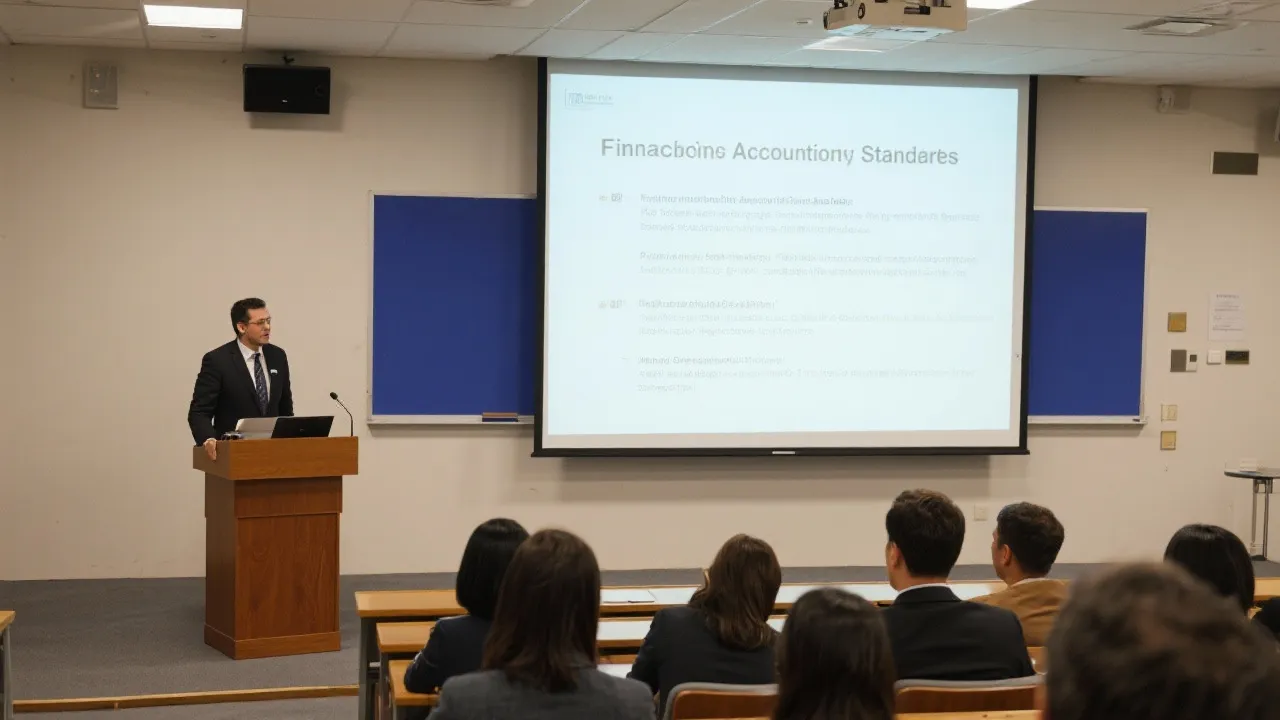Understanding Financial Reporting Standards
This guide covers key insights into Financial Accounting Standard 97 (FAS 97), a crucial framework for insurance contract accounting. FAS 97 was established to address inconsistencies in insurance contract reporting, providing a structured method for recognizing income and liabilities. This article delves into how FAS 97 impacts financial transparency and decision-making for insurance entities.

Introduction to FAS 97
Financial Accounting Standard 97, commonly referred to as FAS 97, constitutes a groundbreaking step in the field of financial reporting for insurance companies. This standard was introduced to specifically address the complexities and inconsistencies that emerged from diverse accounting practices in insurance contract reporting. Implemented to provide clarity and consistency, FAS 97 has become a cornerstone for companies in managing their financial disclosures, focusing predominantly on three types of insurance products: universal life insurance, investment contracts, and limited-payment contracts. Its introduction has also paved the way for subsequent regulations aimed at refining and enhancing financial disclosures across various industries.
Objectives and Scope of FAS 97
One of the fundamental objectives of FAS 97 is to align income recognition with the underlying economic realities of the insurance contracts. Before its inception, varied practices in reporting made it challenging for analysts and stakeholders to extract meaningful insights from financial statements. With FAS 97, organizations are now required to differentiate between the costs associated with acquiring insurance contracts and the profits that arise from these contracts over time. This ensures that the reported financial results better reflect the firm's performance and present a transparent view of its financial health. Moreover, the standard encourages firms to enhance their financial reporting processes, which can lead to better stakeholder relationships and improved investor confidence.
Implementation and Impact on Insurance Companies
The implementation of FAS 97 requires a detailed understanding of the nature of insurance contracts. For universal life-type contracts, which allow policyholders flexibility in terms of premium payments and coverage amount, FAS 97 mandates that insurers separate the account value from the insurance component. This bifurcation allows for a more accurate representation of the liabilities, ensuring that the funds held in the account are not erroneously misinterpreted as insurance revenue. For investment and limited-payment contracts, the standard necessitates different methodologies for amortizing acquisition costs, ensuring that these are not lost in the year they’re incurred but rather matched appropriately with the revenue generated through the contract term. This matching principle reinforces the accuracy of reported earnings and assists analysts when forecasting future profitability, ultimately contributing to more stable share prices and reduced volatility in capital markets.
Technical Aspects of FAS 97
The essence of FAS 97 lies in its ability to break down the financial mechanics of complex policies into digestible, transparent financial records. Under this standard, income is recognized in a manner that reflects the timing and risks of the insurance entity. Companies use various methods, such as retrospective deposit accounting, to ensure that the financial implications of policyholder behavior and actuarial assumptions are adequately captured. These technical details, though complex, play a crucial role in financial reporting, as they provide a standardized lens through which investors and analysts can evaluate the company's performance. Additionally, FAS 97 introduces requirements regarding disclosures related to the nature of the insurance contracts in question, which further enhances comparability across entities operating in similar markets. The thorough documentation of actuarial assumptions and methodologies not only bolsters the reliability of financial statements but also assists regulators in monitoring compliance with established standards.
Challenges in Adopting FAS 97
Although FAS 97 offers significant improvements in reporting standards, it poses its own set of challenges, particularly for insurers grappling with legacy systems that were never designed to accommodate such precise accounting requirements. Upgrading these systems entails significant investment in technology and training, and organizations often encounter resistance during the transition phase. There is also a steep learning curve associated with understanding the intricacies of FAS 97—financial personnel must be well-versed in the methodologies applicable to various types of contracts to ensure accurate reporting. Moreover, the standard demands ongoing updates to actuarial assumptions and projections, requiring companies to maintain a high level of expertise and attention to detail within their financial departments. As part of managing this transition, insurers may need to engage external consultants or auditors, incurring additional costs that can strain existing budgets. These hurdles necessitate a comprehensive change management strategy to facilitate a smooth implementation process.
Benefits of Effective FAS 97 Compliance
Despite the hurdles, adhering to FAS 97 brings distinct advantages to insurance entities. Primarily, it enhances the transparency and comparability of financial statements, making it easier for stakeholders to evaluate the company’s financial health. Through clear demarcation of revenue streams and expenses, decision-makers can better allocate resources and strategize for future growth. Furthermore, standardized reporting reduces the risk of financial restatements, thereby boosting investor confidence and potentially enhancing the market valuation of compliant companies. As a result, insurance firms that grasp the complexities of FAS 97 can position themselves favorably against their competitors, fostering a reputation as reliable and trustworthy players in the market. This competitive edge can translate into better terms with counterparties, improved capital access, and an overall enhancement of market share.
FAQs
- What is FAS 97?
FAS 97 is a Financial Accounting Standard that addresses the accounting and reporting of insurance contracts, specifically for universal life insurance, investment contracts, and limited-payment contracts. Its goal is to standardize and clarify the accounting requirements for insurance entities, facilitating better financial reporting.
- Why was FAS 97 implemented?
It was implemented to provide clarity and consistency across financial statements and rectify discrepancies in income and expense recognition for insurance contracts. FAS 97 aimed to enhance transparency in financial disclosures, ensuring that stakeholders can make informed decisions based on accurate information.
- What challenges do companies face with FAS 97?
Challenges include system upgrades, staff training, and the need for continuous updates to actuarial assumptions. Additionally, integrating FAS 97 into existing financial reporting practices can be complex, requiring a cultural shift within organizations to prioritize accurate and transparent reporting.
- How does FAS 97 benefit insurance companies?
It improves the transparency and accuracy of financial statements, facilitating better decision-making and enhancing investor confidence. Compliance with FAS 97 can also lead to more accurate assessments of a company's performance, allowing for better risk management and strategic planning.
Conclusion
FAS 97 stands as a vital component of financial accounting for insurance companies, offering a structured framework that ensures accuracy and transparency. As companies continue to adopt and refine their approaches to comply with these standards, the financial industry as a whole benefits from improved clarity and consistency in financial reporting. For those in the insurance sector, understanding and effectively implementing FAS 97 is not just a regulatory obligation but a pathway to building trust and achieving sustainable success in an increasingly complex financial landscape. The long-term benefits derived from adhering to FAS 97 can greatly outweigh the initial investments, positioning firms for success in a market that increasingly values transparency and reliability in financial disclosures.
The Evolution of FAS Standards in the Insurance Sector
As the landscape of financial accounting continues to evolve, FAS 97 serves as a key reference point in the trajectory of accounting standards within the insurance sector. It played a crucial role in the transition from inflexible, outdated methods of accounting to a more nuanced understanding of complex financial products. Over time, amendments to FAS 97 and subsequent standards reflect the ongoing dialogues among stakeholders regarding the proper treatment of financial instruments and insurance contracts. This ongoing evolution aims not only to clarify reporting requirements but also to adapt to emerging financial practices, technological advancements, and the shifting demands from investors and regulatory bodies. Furthermore, FAS 97 laid the groundwork for international harmonization efforts seen in the development of International Financial Reporting Standards (IFRS), particularly IFRS 17, which addresses similar issues in reporting for insurance contracts globally.
Comparative Analysis of FAS 97 and IFRS 17
To truly appreciate the significance of FAS 97, one must also consider its relationship with IFRS 17, which has emerged as the global standard for insurance contracts. While both FAS 97 and IFRS 17 aim to enhance comparability, consistency, and transparency, the standards differ significantly in their approach and implications. FAS 97 is primarily focused on the segregation of the insurance components, requiring companies to split the investment-related liabilities from those related to insurance coverage. In contrast, IFRS 17 introduces a more unified approach where insurance contracts are grouped based on similar risk profiles, fundamentally changing how liabilities are recognized over the contract's life. This shift aims to provide a more comprehensive view of the profitability of insurance contracts and encourage insurers to consider the future cash flows relevant to those contracts.
Moreover, IFRS 17 emphasizes the importance of actual cash flows, making it imperative for insurers to have robust forecasting and projection capabilities. The adoption of IFRS 17 is expected to bring a significant change in the reporting practices of companies globally, and its close relationship with FAS 97 results in a consideration for insurance companies operating in jurisdictions adhering to both standards. Both frameworks emphasize the need for actuarial expertise, sophisticated modeling techniques, and state-of-the-art systems to ensure compliance; thus, companies transitioning from FAS 97 to IFRS 17 face unique challenges as they align their reporting practices with the updated requirements.
Current Trends Influencing FAS 97 Compliance
The financial reporting landscape is in constant flux, with emerging trends shaping the implementation and compliance landscape associated with FAS 97. One notable trend is the increasing emphasis on sustainability and environmental, social, and governance (ESG) criteria within financial reporting. Investors are now more inclined to look beyond traditional financial metrics, seeking a broader understanding of how companies are managing risks and opportunities associated with sustainability-related challenges. Insurers that adhere effectively to FAS 97 can leverage their compliance to demonstrate their commitment to transparency and risk management – essential components for meeting the expectations of modern investors.
Additionally, advancements in technology and data analytics play a crucial role in enhancing compliance with FAS 97. Insurers are harnessing the power of big data, artificial intelligence, and machine learning to improve their actuarial assessments and projections, ensuring more accurate financial reporting. These technological advancements allow companies to gather insights that inform strategic decision-making and enhance their forecasting abilities. Furthermore, automation tools streamline the reporting process, reducing manual efforts and minimizing risks associated with errors, thereby fostering a culture of compliance and efficiency.
Looking Ahead: The Future of FAS Standards
As the financial landscape becomes progressively intricate, the future trajectory of FAS standards, including FAS 97, will likely evolve in response to changing industry needs and global economic conditions. Regulatory bodies and standard-setting organizations are expected to maintain an ongoing dialogue with industry stakeholders to refine these standards continually. Future revisions may address emerging products in the insurance sector, such as cyber insurance, tailored insurance policies, and other disruptive innovations. As insurers diversify their product offerings, it will be imperative for accounting standards to keep pace to provide clarity and ensure consistency in financial reporting.
Moreover, the global convergence of accounting standards might necessitate revisions to FAS 97 to align more closely with international standards, including IFRS 17, as mentioned earlier. As companies face the dual pressures of adhering to national regulations while also preparing for potential international operational demands, flexibility and consistency in reporting under FAS 97 will be vital. The adaptation of these standards will undoubtedly require extensive consultation and collaboration with stakeholders across the financial ecosystem to ensure that evolving practices sufficiently address the complexities inherent in insurance contracts.
Conclusion: Embracing Change for Sustainable Success
In conclusion, FAS 97 is a pivotal element in the financial accounting framework for insurance companies, offering significant benefits alongside its challenges. As insurers navigate this evolving landscape, the ability to effectively implement and comply with FAS 97 may serve as a critical success factor in achieving long-term financial health and stability. Transparency, accuracy, and proactive engagement with regulatory developments will be essential components of strategies that allow companies to thrive amidst constant change. By embracing the principles of FAS 97 and integrating them into their operational practices, insurance companies can bolster their reputations, enhance stakeholder trust, and position themselves for sustainable success in an increasingly competitive environment.









